
This is our story…
The unique concept of V&A Dundee was designed by renowned Japanese architect Kengo Kuma. The building combines complex concrete architecture with glass facades and linear concrete cladding.
Concealed with 2, 500 precast panels, the curved in situ walls have been one of the most challenging aspects of the build. Our role was to provide engineering services, bespoke formwork and shoring solutions for all external walls in order to achieve the best possible architectural concrete result.
Why was the structure difficult to build?
The structure comprises elaborate curves conjoined with linear walls which affords the V&A’s unique status as no two walls are the same. Black architectural feature-finish concrete forms the outer walls of the building, layered with 4m wide precast stone panels to represent a rugged Scottish cliff face.
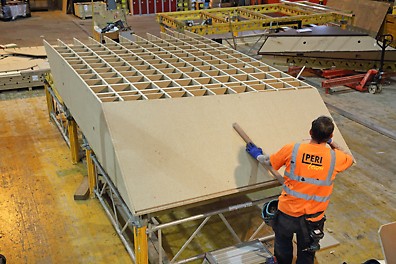
The expectations surrounding accuracy and timeliness raised many challenges for all contractors and suppliers involved. At the peak of the project, our team were fabricating 1,000 m² of bespoke shutters per month.
Tried and tested
Before the main construction had started, a full-size sample panel with reverse curvature and slope was constructed on site. The trial panel was successful in demonstrating buildability, wall geometry, surface finish and colour matching with the specialist lining material being used. It also validated removal of formwork and back propping of the wall panel.

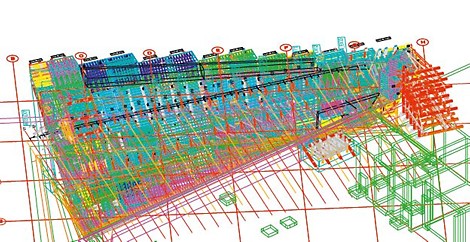
We worked with Arup’s (structural engineer specialists) 3D design model to gauge the amount of structural support required to facilitate the build. Without 3D structural modelling, it would have been almost impossible to transform Kuma’s vision into reality.
Who was involved?
We worked as one team across multiple sites by utilising additional resources from our design and fabrication facilities in the UK, as well as looking further afield for technical expertise from our main facility in Weissenhorn, Germany.
Two of our dedicated project managers oversaw the fabrication and technical requirements. This ensured both processes were aligned across the facilities involved and provided our customer with a direct point of contact to address any potential problems and issues once the project was underway.
At the busiest point of the project, we had a team of over forty designers from various subsidiaries across the world supplying CNC files and fabrication drawings once the 3D design had been finalised.
Overcoming fabrication and logistical demands
The large quantity of shutters required saw us join forces with our team in Germany to produce bespoke timber box outs. Our fabrication teams worked rigorously to fulfil these requirements as no shutter was identical and so attention to detail was crucial. The majority of the box outs were machined in Germany before being sent to our warehouse in Rugby for fabrication, where plywood, VARIO and walers were assembled.
Each shutter was made two layers of 4 mm plywood, 21 mm thick lathing timbers, Cleatbox interlocking chipboard rib grillage and VARIO base panel – SRU walers, GT 24 girder and 21 mm thick chipboard panel face.
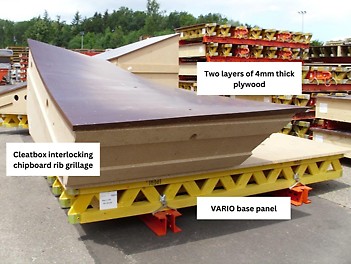
Quantity and quality
Our VARIO panels and VARIOKIT rafters provided a standard 2500mm wide unit with variable depth and height, tailor-made to achieve the structure’s elaborate twists and turns. Our team produced 1,277 bespoke panels, each one crafted with skill and patience to meet the exact requirements of Kuma’s design.
As the outer walls were not self-supporting, we used shoring props to hold the concrete structure until the roof was installed. Once installed, the roof tied the entire structure together, along with additional support from the two cores constructed at the start of the project. Permanent steel beams secured the cores to the lower walls to provide a centralised support base.
PERI UP shoring was the ideal scaffold support for the wall formwork as the height of the scaffold could be adjusted in 250mm increments to facilitate various concrete pours spanning the building.
It was only in February 2017 where the true complexity of the building was revealed, as all shoring props and formwork had been removed.
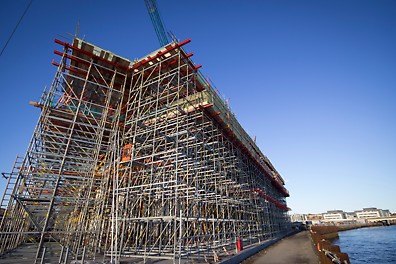
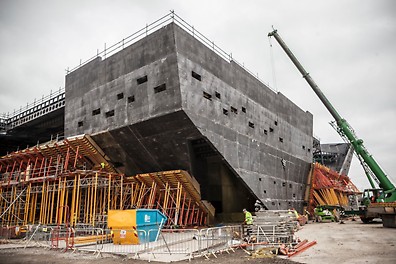
With over 1,500 tonnes of equipment and 1,200 bespoke panels on site, the strength of communication between departments and the wider supply chain could not be underestimated, particularly when transporting formwork equating to approximately 300 truck journeys to the site.
At the time of its construction, V&A Dundee was one of the most technically challenging projects we had ever been involved in. The project provided us with a blueprint for future structural convolutions and will be a memorable part of our journey for years to come.
